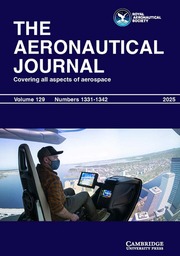No CrossRef data available.
Article contents
Numerical simulation of the DLR combustor considering the thermochemical non-equilibrium effect
Published online by Cambridge University Press: 01 October 2025
Abstract
The present work investigates the thermochemical non-equilibrium effect in the DLR combustor using a two-temperature model combined with vibration-chemistry coupling model. Two operating conditions with inflow Mach 2 and 6 are selected for study. The simulation results illustrate that translational-vibrational non-equilibrium is related to energy transfer behaviour and the translational-vibrational relaxation time. When kinetic energy and chemical energy are converted into internal energy, there is a significant difference in the degree of conversion to translational and vibrational energy. If the translational-vibrational relaxation time is larger than the flow time, such as the relaxation time of the mainstream aftershock wave is 0.25 s for the condition with inflow Mach 2, and the flow time is 3 × 10−5 s, non-equilibrium will occur. Significant differences exist between the flow fields with Mach 2 and 6. A clear boundary layer separation occurs at Mach 6. Combustion occurs at the shear layer, which is in translational-vibrational equilibrium, and there are varying degrees of non-equilibrium in other locations. The dissociation of N2 and production of NO primarily occur on the strut walls and the upper/lower walls of the combustor. The mass fraction of NO is higher than the value at Mach 2. The combustion performance is influenced by the thermochemical non-equilibrium effect. At the condition of Mach 2, it increases the combustion efficiency by 10% near the injector and 0.27% at outlet relatively. Non-equilibrium inhibits the initial upstream combustion while slightly promoting downstream combustion under inflow Mach 6 condition.
Keywords
Information
- Type
- Research Article
- Information
- Copyright
- © The Author(s), 2025. Published by Cambridge University Press on behalf of Royal Aeronautical Society


